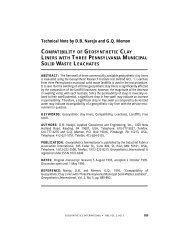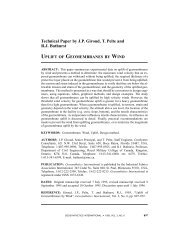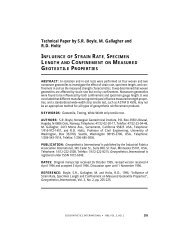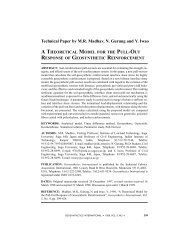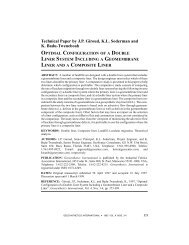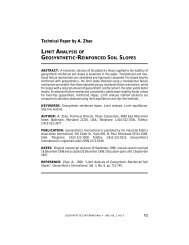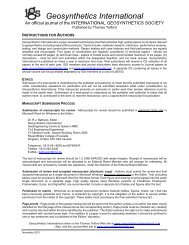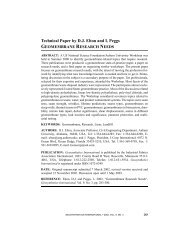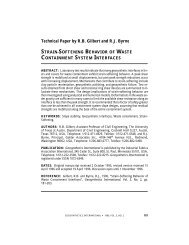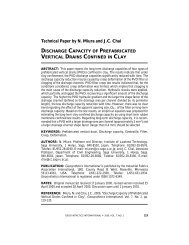Technical Paper by J.H. Greenwood - IGS - International ...
Technical Paper by J.H. Greenwood - IGS - International ...
Technical Paper by J.H. Greenwood - IGS - International ...
You also want an ePaper? Increase the reach of your titles
YUMPU automatically turns print PDFs into web optimized ePapers that Google loves.
<strong>Technical</strong> <strong>Paper</strong> <strong>by</strong> J.H. <strong>Greenwood</strong><br />
DESIGNING TO RESIDUAL STRENGTH OF<br />
GEOSYNTHETICS INSTEAD OF STRESS-RUPTURE<br />
ABSTRACT: The tensile design strength of geosynthetic reinforcement may be governed<br />
<strong>by</strong> strain or load and, in the latter case, some design codes base the design strength<br />
on stress-rupture. However, when a factor of safety is applied, this approach can be<br />
over-conservative. By considering the residual or available strength, it is possible to define<br />
a more realistic procedure that can be integrated with the effects of environmental<br />
degradation and mechanical damage.<br />
KEYWORDS: Geosynthetic reinforcement, Creep, Stress-rupture, Partial safety<br />
factor.<br />
AUTHOR: J.H. <strong>Greenwood</strong>, ERA Technology Ltd., Cleeve Road, Leatherhead,<br />
Surrey KT22 7SA, UK, Telephone: 44/1372-367005, Telefax: 44/1372-367099,<br />
E-mail: john.greenwood@era.co.uk.<br />
PUBLICATION: Geosynthetics <strong>International</strong> is published <strong>by</strong> the Industrial Fabrics<br />
Association <strong>International</strong>, 345 Cedar St., Suite 800, St. Paul, Minnesota 55101-1088,<br />
USA, Telephone: 1/612-222-2508, Telefax: 1/612-222-8215. Geosynthetics<br />
<strong>International</strong> is registered under ISSN 1072-6349.<br />
DATES: Original manuscript received 19 December 1996, revised version received<br />
24 January 1997 and accepted 27 January 1997. Discussion open until 1 November<br />
1997.<br />
REFERENCE: <strong>Greenwood</strong>, J.H., 1997, “Designing to Residual Strength of<br />
Geosynthetics Instead of Stress-Rupture”, Geosynthetics <strong>International</strong>, Vol. 4, No. 1,<br />
pp. 1-10.<br />
GEOSYNTHETICS INTERNATIONAL S 1997, VOL. 4, NO. 1<br />
1
GREENWOOD D Designing to Residual Strength Instead of Stress-Rupture<br />
1 DEFINITION OF UNFACTORED STRENGTH<br />
Design codes such as BS 8006 (1995) prescribe that the design strength of soil reinforcement<br />
should be the load that would lead to failure, or to a maximum acceptable<br />
strain, at the end of the design life. For most materials, failure rather than critical strain<br />
is the dominant design criterion.<br />
The unfactored design strength, T CR , is derived from geosynthetic reinforcement<br />
properties as follows:<br />
S The stress-rupture curve defines the time to failure, t f ,ifaloadT is applied continuously<br />
to the geosynthetic.<br />
S The curve is conventionally plotted as the applied load (or its logarithm) against the<br />
logarithm of time to failure (Figure 1).<br />
S If a design life, t d , is specified, it is then possible <strong>by</strong> extrapolation of the curve to predict<br />
a load T CR that would lead to failure at the end of the design life (Jewell and <strong>Greenwood</strong><br />
1988).<br />
When using partial factors in design, such as prescribed in BS 8006 (1995), the design<br />
load T is obtained <strong>by</strong> increasing the unfactored load <strong>by</strong> a partial load factor, f f , that typically<br />
takes on a value of 1.5, and <strong>by</strong> decreasing the unfactored strength, in this case T CR ,<br />
<strong>by</strong> a partial geosynthetic material factor, f m , to produce a geosynthetic reinforcement<br />
design strength, T D . At any instant of time during the lifetime of the structure, the applied<br />
load should be less than or equal to T D . The partial geosynthetic material factor,<br />
f m , is for reductions, variations and uncertainties in the properties of the geosynthetic.<br />
Using the definitions in BS 8006 (1995), f m is the product of other partial factors including<br />
the following: f m11 for variations in manufacturing; f m12 for the uncertainty in extrapo-<br />
Stress-rupture curve (experimental)<br />
Extrapolated curve<br />
Load, T<br />
T CR<br />
T D<br />
Unfactored strength<br />
Design load<br />
Log t (time)<br />
Design life, t d<br />
Figure 1.<br />
Stress-rupture diagram.<br />
2 GEOSYNTHETICS INTERNATIONAL S 1997, VOL. 4, NO. 1
GREENWOOD D Designing to Residual Strength Instead of Stress-Rupture<br />
lation; f m21 for installation damage; and f m22 for environmental degradation effects including<br />
ultraviolet light, the hydrolysis of polyester, and the oxidation of polyolefins.<br />
The partial material factor, f m is a single factor that is applied to the unfactored design<br />
strength independently of time.<br />
2 RESIDUAL STRENGTH<br />
In spite of its appearance, the stress-rupture curve does not depict the reduction of<br />
available strength with time in the same manner as, for example, the reduction in<br />
strength due to exposure to weathering. Consider a geosynthetic reinforcement under<br />
sustained load T, after a time t 1 take a sample and increase the load until it breaks, and<br />
then measure the strength. Because of the effect of the continuous load, the strength may<br />
be less than the tensile strength of the virgin geosynthetic, but higher than T. Dothe<br />
same after a longer period time, t 2 , and the strength will have reduced further. Finally,<br />
at a certain time t 3 , the strength will have diminished to as little as T itself, and the geosynthetic<br />
will break spontaneously.<br />
The strengths after times t 1 and t 2 are referred to as the residual (or available) strengths<br />
and will be denoted as T R1 and T R2 . Plotted as in Figure 2, T R1 and T R2 form an envelope<br />
which terminates at the point (t 3 ,T). For each applied load, T 1 ,T 2 ,T 3 and so on, there<br />
is a different, thus far, undefined residual strength curve whose location depends on the<br />
applied load. Each residual strength curve meets the stress-rupture curve where the residual<br />
strength equals the applied load (Figure 3).<br />
Load or strength<br />
T<br />
Applied load<br />
T R1<br />
T R2<br />
T R residual<br />
strength curve<br />
Stress-rupture<br />
point<br />
t 1 t 2 t 3<br />
Log t (time)<br />
Figure 2.<br />
Residual strength as a function of time for a single applied load.<br />
GEOSYNTHETICS INTERNATIONAL S 1997, VOL. 4, NO. 1<br />
3
GREENWOOD D Designing to Residual Strength Instead of Stress-Rupture<br />
Stress-rupture curve<br />
Load or strength<br />
T 3<br />
T 2<br />
T 1<br />
T R3<br />
T R2<br />
T R1<br />
Log t (time)<br />
Figure 3. Residual (available) strength curves, T R1 , T R2 and T R3 , as a function of time for<br />
multiple applied sustained loads T 1 , T 2 and T 3 , respectively.<br />
The residual strength will always be greater than the continuous applied load. Its value<br />
will depend on the mechanism of tensile failure; for example, on the ductile failure<br />
of the remaining cross section of the fibre. It is believed that the residual strength may<br />
remain close to the tensile strength of the geosynthetic for most of the design life, decreasing<br />
only shortly before stress-rupture occurs (Figure 3).<br />
The significance of residual strength was pointed out <strong>by</strong> Schardin-Liedtke (1990),<br />
who also remarked on the lack of available data. The residual strength of geosynthetics<br />
can be measured as described previously in this section. Place the geosynthetic specimens<br />
under continuous load as in stress-rupture tests and interrupt the tests before the<br />
specimen breaks. Then increase the load as in a normal tensile test to determine the residual<br />
strength of the geosynthetic specimen. Plot the curve of residual strength against<br />
the time before interruption. Do the same for each level of continuous load. Considerable<br />
scatter in the values of the data may be expected, particularly close to the stressrupture<br />
limit.<br />
3 UNDERESTIMATION OF THE DESIGN STRENGTH, T D<br />
It is the purpose of this study to reveal that certain aspects of the traditional design<br />
procedure for soil geosynthetic reinforcement, as described in Section 1, can lead to<br />
over-dimensioning due to an underestimation of T D .<br />
It is first necessary to consider the reason for applying a factor of safety. If it is intended<br />
to guard against miscalculation of T CR , or in other words, if there is a possibility<br />
that the actual load applied to the geosynthetic is in fact T CR , then the traditional method<br />
of a design based on stress-rupture is correct. If on the other hand the purpose of the<br />
factor of safety is to keep some strength in reserve to allow for sudden or short-lived<br />
excess loads, then the partial safety factors should reflect the ratio between the applied<br />
4 GEOSYNTHETICS INTERNATIONAL S 1997, VOL. 4, NO. 1
GREENWOOD D Designing to Residual Strength Instead of Stress-Rupture<br />
load and the available strength. The available strength is equal to the residual strength<br />
as defined in Section 2.<br />
In the following sections of this paper, it is assumed that the load applied is equal to<br />
the design strength, T D . The design strength, T D , was calculated as being equal to T CR /f m<br />
at the design life t d . In fact, the available or residual strength at t d is higher, and equal<br />
to T RD in Figure 4. The effective factor of safety is increased from T CR /T D (= f m )toT RD /T D<br />
(> f m ).<br />
4 THE BRITTLE FRACTURE MODEL<br />
Stress-rupture and residual strength have been described mathematically for polyaramid<br />
fibres (Christensen 1981; Wagner et al. 1986). For polyester fibres, as for polyaramid,<br />
the gradient of the stress-rupture graph plotted on a double logarithmic scale (log<br />
σ against log t, whereσ equals the applied stress) is low in value; for polyester, the<br />
stress-rupture gradient is typically -1/40. If a power law is fitted to the creep curve,<br />
Christensen concludes that the residual strength is insensitive to the previous application<br />
of constant stress so long as the time period of constant stress application is not<br />
close to the ultimate lifetime.<br />
As a simple illustration, let us consider the fibres to be completely brittle, with failure<br />
governed <strong>by</strong> crack growth alone. The empirical Paris law (Paris and Erdogan 1963) relates<br />
the rate of crack growth to the stress concentration factor as follows:<br />
da<br />
(1)<br />
dt = AKn<br />
Stress-rupture curve<br />
T RD<br />
Residual strength curve<br />
corresponding to T D<br />
Load, T<br />
T CR<br />
Unfactored strength<br />
T D<br />
Design strength or applied load<br />
Log t (time) Design life, t d<br />
Figure 4. Definition of T RD , the residual strength at the end of the design life, t d , under a<br />
sustained load T D (T CR /T D =f m ; T RD /T D > f m ).<br />
GEOSYNTHETICS INTERNATIONAL S 1997, VOL. 4, NO. 1<br />
5
GREENWOOD D Designing to Residual Strength Instead of Stress-Rupture<br />
where: a = crack length; A = a constant; n = index; and, K = stress concentration factor<br />
which is equal to σYa ½ for simple geometries, where σ = applied stress and Y =geometrical<br />
factor (Evans and Wiederhorn 1974). For any value of crack length, a, thereisa<br />
corresponding residual strength σ t with an initial value of σ 0 , corresponding to a critical<br />
value of K=K IC . By expressing σ t as a function of time and integrating, it can be shown<br />
that σ t is given <strong>by</strong> the following expression:<br />
σ n−2<br />
t<br />
= σ n−2<br />
0<br />
− σ n t B <br />
where B =2/((n - 2) AY 2 K n−2<br />
IC<br />
), omitting any effects of crack growth during tensile testing.<br />
The stress-rupture curve is given <strong>by</strong> setting σ = σ t which requires solving the following<br />
equation:<br />
(2)<br />
σ n−2<br />
t<br />
= σ n−2<br />
0<br />
− σ n t<br />
t B <br />
Since n is usually large and σ 0 > σ t , Equation 3 can be approximated using the following<br />
expression:<br />
σ n−2<br />
0<br />
= σ n t<br />
t B <br />
which plots as a double logarithmic stress-rupture diagram, and has a gradient of -(1/n).<br />
As mentioned above, for polyester the stress-rupture gradient is of the order of -1/40<br />
and thus n is equal to 40. Thus, if the values σ 0 =1,B =10 - 6 and n = 40 are substituted<br />
into Equation 2, then for an applied load of σ = 0.6 (i.e. 60% of tensile strength), the<br />
time to failure is 748 hours. After 720 hours, the residual strength is 91.7%, after 730<br />
hours it is 90.6%, and after 740 hours it is 88.7%, before reducing to 60% at failure.<br />
This example illustrates how a stress-rupture curve with a low gradient ( -1/n), as observed<br />
in geotextiles, may be associated with a high residual strength over most of the<br />
design life. This index implies that the majority of crack growth takes place just before<br />
failure, and thus the residual strength remains close to the original tensile strength. A<br />
complete model would have to incorporate the processes of primary and secondary<br />
creep, with decreasing and constant strain rates, respectively, as well as the chemical<br />
aspects of the fracture of polymer chains (Horrocks 1996).<br />
(3)<br />
(4)<br />
5 REVISED DESIGN PROCEDURE<br />
5.1 Residual Strength Due to Sustained Load Alone<br />
It is proposed that instead of using the stress-rupture curve directly, the design<br />
strength could be based on the residual strength curve, T R , corresponding to the anticipated<br />
design strength, T D .AvalueofT D must be found such that at the end of the design<br />
life, a factor of safety, f m , will remain between the design strength and the residual or<br />
available strength, T RD , such that T D =T RD /f m (Figure 5). In the absence of an analytical<br />
6 GEOSYNTHETICS INTERNATIONAL S 1997, VOL. 4, NO. 1
GREENWOOD D Designing to Residual Strength Instead of Stress-Rupture<br />
Stress-rupture curve<br />
Residual strength curve at T = TD<br />
Residual strength at t = t d<br />
Load, T<br />
T CR<br />
T D<br />
Unfactored strength<br />
Design strength or applied load<br />
T RD<br />
Log t (time)<br />
Figure 5. Redefinition of T D such that T D =T RD /f m .<br />
Design life, t d<br />
function to describe the residual strength curves, an iterative process will be required<br />
to derive T D .<br />
5.2 Residual Strength Due to Sustained Load, Mechanical Damage and the<br />
Environment<br />
A procedure based on residual strength has the further advantage that it can easily<br />
incorporate degradations due to other effects. Figure 6 shows the residual strength due<br />
to sustained load, mechanical damage and environmental effects individually. If all of<br />
the effects - load, mechanical damage and environmental - apply simultaneously but<br />
without any synergistic effects, such as environmental stress cracking, the degradation<br />
curves expressed as fractions of the initial tensile strength may be multiplied to provide<br />
a set of reduced residual strength curves as shown in Figure 7. The design strength T D<br />
may then be calculated such that, at time t d , T RD /T D =f m in the same manner as shown<br />
in Figure 4 but using the reduced curves.<br />
In dealing with stress-rupture or residual strength, it is important to recognise that<br />
where the geosynthetic reinforcement is under variable load along its length (e.g. due<br />
to interlock with the soil) one should always consider the point of maximum load, as<br />
this is the point where the geosynthetic will break. However, when calculating the total<br />
creep strain, it is necessary to calculate the distribution of load arising from an applied<br />
load T D along the whole load-bearing length of the geosynthetic reinforcement, taking<br />
into account any reduction due to a transfer of load from the geosynthetic reinforcement<br />
to the soil. From this it is possible to derive the total time-dependent strain, which may<br />
then be compared with the criterion for serviceability or maximum strain.<br />
GEOSYNTHETICS INTERNATIONAL S 1997, VOL. 4, NO. 1<br />
7
GREENWOOD D Designing to Residual Strength Instead of Stress-Rupture<br />
Sustained load curves<br />
Mechanical damage<br />
Load, T<br />
Environmental<br />
Stress-rupture curve<br />
Log t (time)<br />
Figure 6. Residual strength curves due to sustained load, mechanical damage and<br />
environmental effects.<br />
Curve for T=T D<br />
Load, T<br />
T RD<br />
T D<br />
Design strength or applied load<br />
Log t (time)<br />
Design life, t d<br />
Figure 7. Combined residual strength curves for sustained load, mechanical damage and<br />
environmental effects; redefinition of T D such that T RD /T D =f m .<br />
8 GEOSYNTHETICS INTERNATIONAL S 1997, VOL. 4, NO. 1
GREENWOOD D Designing to Residual Strength Instead of Stress-Rupture<br />
ACKNOWLEDGMENTS<br />
This paper is an extended version of a discussion contribution made at IS Kyushu<br />
1996. I thank D. Kingston, M. McCreath, W. Voskamp and P. Segrestin for helpful discussions<br />
and the Directors of ERA Technology for permission to publish this paper.<br />
REFERENCES<br />
BS 8006, 1995, “Code of Practice for Strengthened/Reinforced Soils and Other Fills”,<br />
British Standards Institution, London, UK, 170 p.<br />
Christensen, R.M., 1981, “Residual-Strength Determination in Polymeric Materials”,<br />
Journal of Rheology, Vol. 25, No. 4, pp. 529-536.<br />
Evans, A.G. and Wiederhorn, S.M., 1974, “Proof Testing of Ceramic Materials - An<br />
Analytical Basis for Failure Predictions”, <strong>International</strong> Journal of Fracture Mechanics,<br />
Vol. 10, No. 3, pp. 379-392.<br />
Horrocks, A.R., 1996, “The Effect of Stress on Geosynthetic Durability”, Geosynthetics:<br />
Applications, Design and Construction”, de Groot, M.B., den Hoedt, G. and Termaat,<br />
R.J., Editors, Balkema, pp. 629-636.<br />
Jewell, R.A. and <strong>Greenwood</strong>, J.H., 1988, “Long-Term Strength and Safety in Steep Soil<br />
Slopes Reinforced <strong>by</strong> Polymer Materials”, Geotextiles and Geomembranes, Vol.7,<br />
Nos. 1 and 2, pp. 81-118.<br />
Paris, P.C. and Erdogan, F., 1963, “A Critical Analysis of Crack Propagation Laws”,<br />
Transactions of ASME Journal Basic Engineering, Vol. 85, pp. 528-534.<br />
Schardin-Liedtke, H., 1990, “Geotextiles for the Support of Steep Slopes: Approval<br />
Procedure”, Proceedings of the Fourth <strong>International</strong> Conference on Geotextiles,<br />
Geomembranes and Related Products, Balkema, Vol. 1, The Hague, The Netherlands,<br />
May 1990, pp. 79-85.<br />
Wagner, H.D., Schwartz, P. and Phoenix, S.L., 1986, “Lifetime Statistics for Single Kevlar<br />
49 Filaments in Creep-Rupture”, Journal of Materials Science, Vol. 21, No. 6,<br />
pp. 1868-1878.<br />
NOTATIONS<br />
Basic SI units are given in parentheses.<br />
A = constant (Pa -n m 1-n/2 )<br />
a = crack length (m)<br />
B = 2/((n - 2) AY 2 K n−2<br />
IC )(Pa 2 s)<br />
f f = partial load factor (dimensionless)<br />
f m = partial material factor (dimensionless)<br />
f m11 = partial factors for variations in manufacturing (dimensionless)<br />
GEOSYNTHETICS INTERNATIONAL S 1997, VOL. 4, NO. 1<br />
9
GREENWOOD D Designing to Residual Strength Instead of Stress-Rupture<br />
f m12 = partial factors for the uncertainty in extrapolation (dimensionless)<br />
f m21 = partial factor for installation damage (dimensionless)<br />
f m22 = partial factor for environmental effects (e.g. ultraviolet light, hydrolysis<br />
of polyester and oxidation of polyolefins) (dimensionless)<br />
K = stress concentration factor = σYa ½ for simple geometries (Pa m ½ )<br />
K IC = initial critical stress concentration factor (Pa m ½ )<br />
n = index value (dimensionless)<br />
T = applied load (N/m)<br />
T CR = unfactored design strength (N/m)<br />
T D = geosynthetic reinforcement design strength (N/m)<br />
T R = residual (or available) geosynthetic strength (N/m)<br />
t = time (s)<br />
t d = design life (s)<br />
t f = time to failure (s)<br />
Y = geometrical factor (dimensionless)<br />
σ = applied stress (N/m 2 )<br />
σ 0 = initial strength (N/m 2 )<br />
σ t = residual strength (N/m 2 )<br />
10 GEOSYNTHETICS INTERNATIONAL S 1997, VOL. 4, NO. 1
Discussion and Closure<br />
DESIGNING TO RESIDUAL STRENGTH OF<br />
GEOSYNTHETICS INSTEAD OF STRESS-RUPTURE<br />
TECHNICAL NOTE UNDER DISCUSSION: <strong>Greenwood</strong>, J.H., 1997, “Designing<br />
to Residual Strength of Geosynthetics Instead of Stress-Rupture”, Geosynthetics<br />
<strong>International</strong>, Vol. 4, No. 1, pp. 1-10.<br />
DISCUSSER: S-C.R. Lo, Senior Lecturer, School of Civil Engineering, University<br />
College, University of New South Wales, Canberra, Australia, Telephone:<br />
1/61-6-2688349, Telefax: 1/61-6-2688337, E-mail: srl@octarine.cc.adfa.oz.au.<br />
PUBLICATION: Geosynthetics <strong>International</strong> is published <strong>by</strong> the Industrial Fabrics<br />
Association <strong>International</strong>, 1801 County Road B West, Roseville, Minnesota<br />
55113-4061, USA, Telephone: 1/612-222-2508, Telefax: 1/612-631-9334.<br />
Geosynthetics <strong>International</strong> is registered under ISSN 1072-6349.<br />
REFERENCES OF DISCUSSION AND CLOSURE: Lo, S-C.R., 1997,<br />
“Discussion of ‘Designing to Residual Strength of Geosynthetics Instead of<br />
Stress-Rupture’ <strong>by</strong> <strong>Greenwood</strong>, J.H.”, Geosynthetics <strong>International</strong>, Vol. 4, No. 6, pp.<br />
673-675.<br />
<strong>Greenwood</strong>, J.H., 1997, “Closure of Discussion of ‘Designing to Residual Strength of<br />
Geosynthetics Instead of Stress-Rupture’”, Geosynthetics <strong>International</strong>, Vol. 4, No. 6,<br />
pp. 675-677.<br />
Discussion <strong>by</strong> S-C.R. Lo<br />
The author of the paper has presented a more rational and less conservative method<br />
for assessing the load carrying capacity of geosynthetics under long term loading. However,<br />
clarifications are needed to ensure the proposed method is applied in a way compatible<br />
with the design conditions and philosophy of the design code used. The latter<br />
cannot be over-emphasised because of the introduction of limit state design codes that<br />
use a series of somewhat confusing partial factors.<br />
In a limit state design code, partial factors are used in lieu of a single factor of safety.<br />
The design strength, T D , is obtained <strong>by</strong> applying a partial factor f m to T CR , the rupture<br />
strength at the specified design life obtained <strong>by</strong> extrapolation of test data. In the context<br />
of limit state design, f m is used to cover uncertainties in the determination of T CR and the<br />
loss in effective load carrying area (say, due to construction damage). In BS 8006<br />
(1995), f m is considered as the product of a number of partial factors f m11 , f m12 ,etc.in<br />
GEOSYNTHETICS INTERNATIONAL S 1997, VOL. 4, NO. 6<br />
673
DISCUSSION AND CLOSURE D Designing to Residual Strength Instead of Stress-Rupture<br />
attempt to establish a clear link between partial factors and sources of uncertainties/errors.<br />
But f m is not used to take into account short term overload. However, this does not<br />
invalidate the method proposed <strong>by</strong> the author because the design reinforcement tension,<br />
T * , which has to be less than or equal to T D , also contains partial load factors. Thus the<br />
sustained reinforcement tension, T S , is always less than T D as evident from the following<br />
fundamental inequality:<br />
T S ≤ T * ≤ T D<br />
(5)<br />
Hence the residual strength curve has to pass through T S instead of T D as illustrated in<br />
Figure 8, and this leads to a higher residual strength. The use ofT S in defining the residual<br />
strength curve will also avoid the duplication of conservatism if the f m value is selected in<br />
a conservative manner. The relevant limit state design equation becomes the following:<br />
T * ≤ T res ∕ f m<br />
(6)<br />
where T res is the residual strength at the design life. However, the determination of T S is<br />
not straight forward. It is important to emphasise that T S may be higher than the unfactored<br />
reinforcement tension, T O , as determined from a simple calculation model. This is<br />
due to: (i) lock in reinforcement tension because of compaction stresses (Enrich and<br />
Mitchell 1994); and (ii) mobilized soil strength parameters lower than those used in the<br />
design calculations. The latter condition is unlikely for a geosynthetic-reinforced soil<br />
wall if the critical state friction angle is specified in the design code, but conceivable if<br />
peak strength parameters are used in the calculation of T O . In the case ofBS 8006(1995),<br />
where peak soil strength parameters are used, it may be adequately conservative to estimate<br />
T S <strong>by</strong> increasing the unfactored reinforcement tension <strong>by</strong> approximately 25%. A<br />
Stress rupture line<br />
Residual strength curves<br />
Load or strength<br />
T CR<br />
T D<br />
T S<br />
<strong>Greenwood</strong> (1997)<br />
Proposed<br />
Design life<br />
Log t (time)<br />
Figure 8. Residual strength curves as a function of time for an applied load and the stress<br />
rupture line.<br />
674 GEOSYNTHETICS INTERNATIONAL S 1997, VOL. 4, NO. 6
DISCUSSION AND CLOSURE D Designing to Residual Strength Instead of Stress-Rupture<br />
lower factor is appropriate if the critical state friction angle, orfactored strength parameters,<br />
are used in the design. Thus the conversion from T * ,orT O ,toT S is code dependent.<br />
The term “overloading” in the context of reinforcement rupture of a reinforced soil<br />
structure really means overloading of the reinforcement elements. As such, an extreme<br />
(hence short lived) increase in surcharge on the wall may only be a minor contributor<br />
to “overloading”. In geotechnical engineering, “overloading” can be long term or short<br />
lived. Long term “overloading” can be caused <strong>by</strong> soil strength parameters lower than<br />
those assumed in the design and is conceivable if the design is based on unfactored<br />
peak strength parameters. The residual strength method appears to be for short-lived<br />
“overloading”. It is likely that the most severe “overloading” considered in a design<br />
(as specified <strong>by</strong> a load combination and partial load factors) is short-lived, and the residual<br />
strength method is most appropriate. However, a less severe “overloading” of a<br />
long term nature is still possible. This condition needs to be defined, say, <strong>by</strong> another<br />
load combination with less severe partial load factors, and be checked using the stress<br />
rupture method.<br />
A related point that needs clarification is how the residual strength needs to be determined.<br />
Figure 2 of the author’s paper and the empirical Equation 4 for polyester appear<br />
to suggest a quick tensile test. In reinforced soil structures, even short-lived “overloading”<br />
is rarely transient in nature but may have a duration of days or weeks. This is because<br />
short-lived “overloading” may be caused <strong>by</strong> an increase in pore water pressure<br />
(say, due to more severe flooding than that specified) or over-excavation, etc. Hence,<br />
the geotechnical community and code drafting bodies have to agree on a duration for<br />
short-lived “overloading”. Once such an agreement is reached, the residual strength<br />
curve can be determined <strong>by</strong> maintained load tests where the residual strengths are available<br />
for the specified duration.<br />
REFERENCE<br />
Enrich M. and Mitchell, J.K., 1994, “Working Stress Design for Reinforced Soil<br />
Walls”, Journal of Geotechnical Engineering, Vol. 120, No. 4, pp. 625-645.<br />
Closure <strong>by</strong> J.H. <strong>Greenwood</strong><br />
The intention of the author’s paper was to point out that static load can be treated as a<br />
factor that leads to a gradual reduction in strength in the same manner as ultraviolet light<br />
or a chemical agent. This will lead to partial safety factors that are more realistic than<br />
those obtained <strong>by</strong> considering the stress-rupture diagram. The discusser is right to point<br />
out that this must be integrated correctly into current codes for designing reinforced<br />
soil. The various load levels, T, should be defined with care and the reason for applying<br />
each individual partial safety factor should be examined.<br />
The following is a simple numerical example to illustrate further the relation between<br />
residual strength and stress-rupture. Suppose that the residual strength T R decreases linearly<br />
with time from an initial value of unity and in proportion to (using the discusser’s<br />
notation) the sustained load T S as follows:<br />
GEOSYNTHETICS INTERNATIONAL S 1997, VOL. 4, NO. 6<br />
675
DISCUSSION AND CLOSURE D Designing to Residual Strength Instead of Stress-Rupture<br />
T R = 1 − T S t ∕ 10<br />
(7)<br />
The result is a group of curves which are plotted against log time, t in Figure 9. The<br />
residual strengths at higher applied loads fall more rapidly than those at lower loads.<br />
Each test ends with rupture when T S =T R ,or:<br />
T R = 1 ∕ (1 + t ∕ 10)<br />
(8)<br />
This is the stress-rupture graph and is plotted as a thick line in Figure 9.<br />
Noting the lack of data, it is now possible to quote the following results. Fifteen specimens<br />
of various polyester yarns had been placed under a constant load at 50% of their<br />
respective tensile strengths for a period of 55700 hours (6.4 years; log t = 4.75) when the<br />
tests were interrupted in August 1997 and the tensile strengths measured (the question<br />
of the duration of short-term overloading was not considered). The creep strain values<br />
ranged between 5.6 and 7.2%. The mean log t value for the same yarns under a sustained<br />
load of 60% of the tensile strength at 20_C was measured as 3.84 (t = 6950 hours).<br />
<strong>Greenwood</strong> and Yeo (1996) presented the stress-rupture graph of Fortrac geogrid,<br />
which is made from similar yarns, and showed the gradient of the applied load plotted<br />
against log t to be -3.83% of the tensile strength. The sustained load corresponding to<br />
55,700 hours is thus 60 - 3.83×(4.75 - 3.84) = 56.5%; thus, the yarns were exposed at<br />
50÷56.5×100 = 88% of the load that would have led to rupture at the end of the test.<br />
The residual strengths of the yarns are given in Table 1. The test results in Table 1 indicate<br />
that the strength is effectively unchanged under these conditions.<br />
1<br />
0.9<br />
0.8<br />
Percent Tensile tensile strength strength ratio<br />
0.7<br />
0.6<br />
0.5<br />
0.4<br />
0.3<br />
0.2<br />
0.1<br />
0<br />
residual strength for applied load 0.1<br />
residual strength for applied load 0.2<br />
residual strength for applied load 0.3<br />
residual strength for applied load 0.4<br />
residual strength for applied load 0.5<br />
residual strength for applied load 0.6<br />
residual strength for applied load 0.7<br />
residual strength for applied load 0.8<br />
residual strength for applied load 0.9<br />
stress-rupture<br />
0.1 1 10 100<br />
Time (hours)<br />
Figure 9. Residual strength and stress-rupture plotted on a logarithmic scale for a<br />
reduction in strength that depends linearly on time and sustained load.<br />
676 GEOSYNTHETICS INTERNATIONAL S 1997, VOL. 4, NO. 6
DISCUSSION AND CLOSURE D Designing to Residual Strength Instead of Stress-Rupture<br />
Table 1.<br />
The residual strengths of yarns after 55,700 hours at 50% tensile strength.<br />
Yarn type Initial strength (N) Residual strength (N) Percent residual strength<br />
Type A 76.6 77.2 100.7<br />
Type B (undamaged) 77.2 75.2 97.3<br />
Type B (damaged) 66.7 64.9 97.4<br />
Type C 75.0 74.4 99.3<br />
Type D 74.0 76.9 103.9<br />
ACKNOWLEDGMENTS<br />
The author of the paper thanks W. Voskamp for permission to publish the test results<br />
reported in Table 1.<br />
REFERENCE<br />
<strong>Greenwood</strong>, J.H. and Yeo, K.C., 1996, “Assessment of Geogrids for Soil Reinforcement<br />
in Hong Kong”, Earth Reinforcement, Ochiai, H., Yasufuku, N. and Omine K.,<br />
Editors, Balkema, Proceedings of the <strong>International</strong> Conference on Earth Reinforcement,<br />
Fukuoka, Kyushu, Japan, November 1996, pp. 363-367.<br />
GEOSYNTHETICS INTERNATIONAL S 1997, VOL. 4, NO. 6<br />
677



